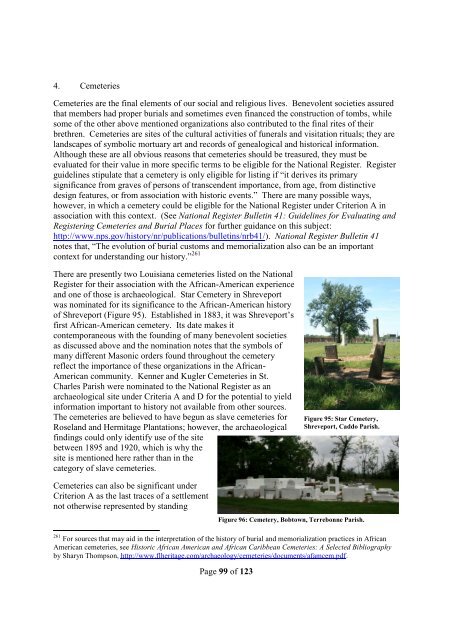The African American Experience in Louisiana
The_African_American_Experience_in_Louisiana
The_African_American_Experience_in_Louisiana
- No tags were found...
You also want an ePaper? Increase the reach of your titles
YUMPU automatically turns print PDFs into web optimized ePapers that Google loves.
4. Cemeteries<br />
Cemeteries are the f<strong>in</strong>al elements of our social and religious lives. Benevolent societies assured<br />
that members had proper burials and sometimes even f<strong>in</strong>anced the construction of tombs, while<br />
some of the other above mentioned organizations also contributed to the f<strong>in</strong>al rites of their<br />
brethren. Cemeteries are sites of the cultural activities of funerals and visitation rituals; they are<br />
landscapes of symbolic mortuary art and records of genealogical and historical <strong>in</strong>formation.<br />
Although these are all obvious reasons that cemeteries should be treasured, they must be<br />
evaluated for their value <strong>in</strong> more specific terms to be eligible for the National Register. Register<br />
guidel<strong>in</strong>es stipulate that a cemetery is only eligible for list<strong>in</strong>g if “it derives its primary<br />
significance ificance from graves of persons of transcendent importance, from age, from dist<strong>in</strong>ctive<br />
design features, or from association with historic events.” <strong>The</strong>re are many possible ways,<br />
however, <strong>in</strong> which a cemetery could be eligible for the National Register under Criterion A <strong>in</strong><br />
association with this context. (See National Register Bullet<strong>in</strong> 41: Guidel<strong>in</strong>es for Evaluat<strong>in</strong>g and<br />
Register<strong>in</strong>g Cemeteries and Burial Places for further guidance on this subject:<br />
http://www.nps.gov/history/nr/publications/bullet<strong>in</strong>s/nrb41/). National Register Bullet<strong>in</strong> 41<br />
notes that, “<strong>The</strong> evolution of burial customs and memorialization also can be an important<br />
context for understand<strong>in</strong>g our history.” 261<br />
<strong>The</strong>re are presently two <strong>Louisiana</strong> cemeteries listed on the National<br />
Register for their association with the <strong>African</strong>-<strong>American</strong> experience<br />
and one of those is archaeological. Star Cemetery <strong>in</strong> Shreveport<br />
was nom<strong>in</strong>ated for its significance to the <strong>African</strong>-<strong>American</strong> history<br />
of Shreveport (Figure 95). Established <strong>in</strong> 1883, it was Shreveport’s<br />
first <strong>African</strong>-<strong>American</strong><strong>American</strong> cemetery. Its date makes it<br />
contemporaneous with the found<strong>in</strong>g of many benevolent societies<br />
as discussed above and the nom<strong>in</strong>ation notes that the symbols of<br />
many different Masonic orders found throughout the cemetery<br />
reflect the importance of these organizations <strong>in</strong> the <strong>African</strong>-<br />
<strong>American</strong> community. Kenner and Kugler Cemeteries <strong>in</strong> St.<br />
Charles Parish were nom<strong>in</strong>ated to the National Register as an<br />
archaeological site under Criteria A and D for the potential to yield<br />
<strong>in</strong>formation important to history not available from other sources.<br />
<strong>The</strong> cemeteries are believed to have begun as slave cemeteries for<br />
Roseland and Hermitage Plantations; however, the archaeological<br />
f<strong>in</strong>d<strong>in</strong>gs could only identify use of the site<br />
between 1895 and 1920, which is why the<br />
site is mentioned here rather than <strong>in</strong> the<br />
category of slave cemeteries.<br />
Figure 95: Star Cemetery,<br />
Shreveport, Caddo Parish.<br />
Cemeteries can also be significant under<br />
Criterion A as the last traces of a settlement<br />
not otherwise represented by stand<strong>in</strong>g<br />
Figure 96: Cemetery, Bobtown, Terrebonne Parish.<br />
261 For sources that may aid <strong>in</strong> the <strong>in</strong>terpretation of the history of burial and memorialization practices <strong>in</strong> <strong>African</strong><br />
<strong>American</strong> cemeteries, see Historic <strong>African</strong> <strong>American</strong> and <strong>African</strong> Caribbean Cemeteries: A Selected Bibliography<br />
by Sharyn Thompson, http://www.flheritage.com/archaeology/cemeteries/documents/afamcem.pdf.<br />
Page 99 of 123


